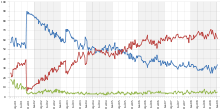Presidency of George W. Bush
| Presidency of George W. Bush | |
|---|---|
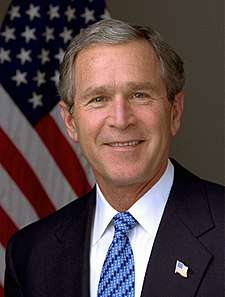 | |
| In office | |
| January 20, 2001 – January 20, 2009 | |
| Preceded by | Clinton presidency |
| Succeeded by | Obama presidency |
| Seat | White House, Washington, D.C. |
| Political party | Republican |
| ||
|---|---|---|
|
Governor of Texas
43rd President of the United States
Policies
Appointments
First term
Second term
Post-presidency
 |
||
The presidency of George W. Bush began at noon EST on January 20, 2001, when George W. Bush was inaugurated as the 43rd President of the United States, and ended on January 20, 2009. Bush, a Republican, took office following a very close victory over Democratic incumbent Vice President Al Gore in the 2000 presidential election. Four years later, in the 2004 election, he defeated Democrat John Kerry to win re-election. Bush, the 43rd President, is the eldest son of the 41st President, George H. W. Bush. He was succeeded by Democrat Barack Obama, who won the 2008 presidential election.
Upon taking office, Bush pushed through a $1.3 trillion tax cut program and the No Child Left Behind Act, a major education bill. He also pushed for socially conservative efforts, such as the Partial-Birth Abortion Ban Act and faith-based welfare initiatives. After the terrorist attacks on September 11, 2001, Bush declared a global war on terrorism and, in October 2001, ordered an invasion of Afghanistan to overthrow the Taliban, destroy the terrorist group al-Qaeda, and capture Osama bin Laden. That same month, he signed into law the controversial Patriot Act in order to strengthen security and allow for greater surveillance. In 2003, Bush ordered an invasion of Iraq, asserting that Iraq possessed stockpiles of weapons of mass destruction in violation of UN Security Council Resolution 1441. Later that year, he signed the Medicare Prescription Drug, Improvement, and Modernization Act, which created Medicare Part D and made other changes to Medicare.
Bush's second term was highlighted by several free trade agreements, a strong push for offshore and domestic drilling, and the successful nominations of Supreme Court Justices John G. Roberts and Samuel Alito. Bush also sought immigration reform and major changes to Social Security, but both efforts failed. The wars in Afghanistan and Iraq continued, and in 2007 he launched a surge of troops in Iraq. The Bush administration's response to Hurricane Katrina and the dismissal of U.S. attorneys controversy earned wide coverage, and his second term saw a drop in his approval ratings. A global meltdown in financial markets dominated his last days in office as policymakers looked to avert a major economic disaster, and he signed into law the Troubled Asset Relief Program (TARP) through the Emergency Economic Stabilization Act of 2008.
Election of 2000
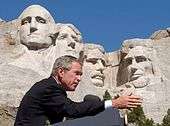
With the help of political adviser Karl Rove, Bush began preparing for a 2000 presidential campaign soon after his victory in the 1994 Texas gubernatorial election. Following the defeat of Republican nominee Bob Dole in the 1996 presidential election, Bush was widely viewed as one of the top contenders for the 2000 Republican nomination.
After a strong re-election victory in the gubernatorial re-election of 1998, Bush became the widely acknowledged front-runner in the race for the nomination. Discouraged by Bush's popularity and strong fundraising, potential Republican candidates such as Jack Kemp and Colin Powell declined to enter the race. In the years preceding the 2000 election, Bush built up his stable of advisers, with his economic advisers led by supply-side economics advocate Lawrence B. Lindsey and his foreign policy team led by Condoleezza Rice. Though several Republicans dropped out of the race rather than challenge Bush, Arizona Senator John McCain launched a spirited challenge that was supported by many moderates and foreign policy hawks. McCain's loss in the South Carolina primary effectively ended the 2000 Republican primaries, and Bush was officially nominated for president at the 2000 Republican National Convention. Bush selected former Secretary of Defense Dick Cheney as his running mate; though Cheney offered little electoral appeal and had health problems, Bush thought that Cheney's extensive experience would make him a valuable governing partner.[1]
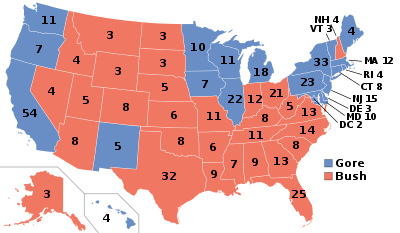
With President Bill Clinton term-limited, the Democrats nominated Vice President Al Gore. Bush's campaign emphasized their own candidate's character in contrast with that of Clinton, who had been embroiled in the Lewinsky scandal for much of his second term. In the presidential debates, Bush exceeded the expectations of many in holding his ground against Gore, and Bush held a substantial lead in several polls taken after the final debate in October. However, the unearthing of a 1976 DUI arrest appeared to sap Bush's momentum, and as election night approached, the race was widely considered to be very close. On election night, several television networks called the race for Gore based on exit polls and early returns, but as the night continued, the networks reversed themselves and called the race for Bush. Florida emerged as the key state in the election, as whichever candidate won the state would win the presidency. Official tallies showed Bush with lead of less than two thousand votes out of a total of two million cast in Florida, and both campaigns dispatched attorneys to engage in the legal battle over the ensuing recount.[2]
The Florida Supreme Court ordered a manual recount of a portion of the ballots, but was overruled by the United States Supreme Court in the case of Bush v. Gore on equal protection grounds. Bush won the election with 271 electoral votes compared to Gore's 266, though Gore narrowly won a plurality of the popular vote. In the concurrent congressional elections, Republicans retained a narrow majority in the House but lost five seats in the Senate to leave the partisan balance at fifty Republicans and fifty Democrats.[2]
Administration
Rejecting the idea of a powerful White House Chief of Staff, Bush had high-level officials report directly to him. Bush brought to the White House several individuals who had worked under him in Texas, including Senior Counselor Karen Hughes, Senior Adviser Karl Rove, legal counsel Alberto Gonzales, and Staff Secretary Harriet Miers. Other important individuals in the White House included National Security Adviser Condoleezza Rice, Chief of Staff Andrew Card, and Vice President Cheney, who emerged as the most powerful individual in the White House aside from Bush himself.[3] Paul H. O'Neill, who had served as Deputy Director of the OMB, was appointed Secretary of the Treasury, while former Missouri Senator John Ashcroft was appointed Attorney General.[4] O'Neill, who opposed the Iraq War and feared that the Bush tax cuts would lead to deficits, was replaced by John W. Snow in February 2003.[5] In June 2006, Snow was succeeded by Henry Paulson, the head of Goldman Sachs, after Bush agreed to let Paulson lead his administration's economic policy.[6] Ashcroft, who differed with Bush on issues such as NSA surveillance, resigned after the 2004 election, and was replaced by Gonzales.[7] After serving as Chief of Staff for more than five years, Card left the White House of his own accord, and was replaced by Joshua Bolten.[8] Gonzales and Rove both left in 2007 after controversy regarding the dismissal of U.S. attorneys, and Gonzales was replaced by Michael Mukasey, a former federal judge.[9]
As Bush had little foreign policy experience, his appointments would serve an important role in dictating the foreign policy of the United States during his tenure. Bush's initial foreign policy appointees had largely served under his father's administration. Vice President Cheney had been Secretary of Defense, National Security Adviser Rice had served on the National Security Council, and deputy secretaries Paul Wolfowitz and Richard Armitage had also served in important roles. Secretary of State Colin Powell had served as Chairman of the Joint Chiefs of Staff under the first President Bush.[10] Bush had long admired Powell, and the former general was Bush's first choice for the position. Secretary of Defense Donald Rumsfeld, who had served in the same position during the Ford administration, rounded out the key figures in the national security team.[11] Rumsfeld and Cheney, who had served together in the Ford administration, were the leading foreign policy figures in Bush's first term.[12] Frustrated by the decisions of the Bush administration, particularly the launching of the Iraq War, Powell resigned following the 2004 elections.[13] He was replaced by Rice, while then-Deputy National Security Adviser Stephen Hadley took Rice's former position.[14] After the 2006 elections, Rumsfeld was replaced by former CIA Director Robert Gates.[15] The personnel shake-ups left Rice as one of the most prominent individuals in the administration, and she played a strong role in directing Bush's second term foreign policy.[16]
Advisors and other officials
- Deputy Secretary of Defense – Paul Wolfowitz (2001–2005), Gordon R. England (2005–2009)
- CIA Director – George Tenet (2001–2004), John E. McLaughlin (acting, 2004), Porter J. Goss (2004–2006), Michael Hayden (2006–2009)
- FBI Director – Louis Freeh (2001), Thomas J. Pickard (acting, 2001), Robert S. Mueller (2001–2009)
- NASA Administrator – Sean O'Keefe (2001–2005), Michael D. Griffin (2005–2009)
- FAA Administrator – Marion Blakey (2002–2007), Robert A. Sturgell (acting) (2007–2009)
- FDA commissioner – Mark McClellan (2002–2004), Lester Crawford (2005), Andrew von Eschenbach (2005–2009)
- National Security Advisor – Condoleezza Rice (2001–2005), Stephen Hadley (2005–2009)
- Deputy National Security Advisor for Iraq and Afghanistan – Meghan O'Sullivan (2004–2007), Douglas Lute (2007–2009)
- Ambassador to the United Nations – John Negroponte (2001–2004), John Danforth (2004); John R. Bolton (2005–2006), Zalmay Khalilzad (2007–2009)
- FCC Chairman – Michael Powell (2001–2005), Kevin Martin (2005–2009)
- White House Deputy Chief of Staff – Joe Hagin (2001–2008), Joshua Bolten (2001–2003), Harriet Miers (2003–2004), Karl Rove (2005–2007), Joel Kaplan (2006–2009), Blake Gottesman (2008–2009)
- Director of National Intelligence – John Negroponte (2005–2007), John Michael McConnell (2007–2009)
- White House Counsel – Alberto R. Gonzales (2001–2005), Harriet Miers (2005–2007), Fred Fielding (2007–2009)
- White House Press Secretary – Ari Fleischer (2001–2003), Scott McClellan (2003–2006), Tony Snow (2006–2007), Dana Perino (2007–2009)
- Senior Advisor to the President – Karl Rove (2001–2007), Barry Steven Jackson (2007–2009)
- Chief of Staff to the Vice President of the United States – Lewis Libby (2001–2005), David Addington (2005–2009)
- Counselor to the President – Karen Hughes (2001–2002), Dan Bartlett (2002–2007), Ed Gillespie (2007–2009)
Military nominations and appointments
- Chairman of the Joint Chiefs of Staff – Richard B. Myers (2001 –2005), Peter Pace (2005 –2007), Michael Mullen (2007 –2011)
- Chief of Staff of the United States Army – Peter Schoomaker (2003–2007), George W. Casey, Jr. (2007 –2011)
- Chief of Staff of the United States Air Force – John P. Jumper (2001–2005), T. Michael Moseley (2005–2008), Norton A. Schwartz (2008-2012)
- Chief of Naval Operations – Michael Mullen (2005–2007), Gary Roughead (2007–2011)
- Commandant of the Marine Corps – Michael Hagee (2003–2006), James T. Conway (2006–2010)
Judicial nominations
After the 2004 election, many expected that Chief Justice William Rehnquist would be forced to step down from the United States Supreme Court. Cheney and White House Counsel Harriet Miers were tasked with finding a suitable replacement, and they settled on D.C. Circuit Court of Appeals John Roberts and Fourth Circuit Judge Michael Luttig, both widely respected conservatives, as the two finalists. In June 2005, Justice Sandra Day O'Connor unexpectedly announced that she would step down from the court, and Bush nominated Roberts for her position the following month. After Rehnquist died in September, Bush briefly considered elevating Associate Justice Antonin Scalia to the position of Chief Justice, but instead chose to nominate Roberts for the position. Roberts won confirmation from the Senate in a 78-22 vote, with all Republicans and a narrow majority of Democrats voting to confirm Roberts. To replace O'Connor, the Bush administration wanted to find a female nominee, but was unsatisfied with the conventional options available. The president settled on Miers, but her nomination immediately faced opposition from conservatives feared her unproven ideology and lack of judicial experience. After Senate Majority Leader Bill Frist informed Bush that Miers did not have the votes necessary to win confirmation, Miers withdrew from consideration. Bush nominated Samuel Alito, who received strong support from conservatives but faced opposition from Democrats. Alito won confirmation in a 58-42 vote in January 2006.[17]
Bush also appointed 62 judges to the United States Courts of Appeals, 261 judges to the United States district courts, and 2 judges to the United States Court of International Trade. Bush appointed Neil Gorsuch to the United States Court of Appeals for the Tenth Circuit in 2006; Gorsuch would later be nominated by President Donald Trump for a seat on the Supreme Court.
Domestic affairs
Bush tax cuts
| Year | Income | Outlays | Surplus/ Deficit |
GDP | Debt as a % of GDP[19] |
|---|---|---|---|---|---|
| 2001 | 1991.1 | 1862.8 | 128.2 | 10564.6 | 31.4 |
| 2002 | 1853.1 | 2010.9 | -157.8 | 10876.9 | 32.5 |
| 2003 | 1782.3 | 2159.9 | -377.6 | 11332.4 | 34.5 |
| 2004 | 1880.1 | 2292.8 | -412.7 | 12088.6 | 35.5 |
| 2005 | 2153.6 | 2472.0 | -318.3 | 12888.9 | 35.6 |
| 2006 | 2406.9 | 2655.1 | -248.2 | 13684.7 | 35.3 |
| 2007 | 2568.0 | 2728.7 | -160.7 | 14322.9 | 35.2 |
| 2008 | 2524.0 | 2982.5 | -458.6 | 14752.4 | 39.3 |
| 2009 | 2105.0 | 3517.7 | -1412.7 | 14414.6 | 52.3 |
| Ref. | [20] | [21] | [22] | ||
Bush's promise to cut taxes was the centerpiece of his 2000 presidential campaign, and upon taking office, he made tax cuts his first major legislative priority. A budget surplus developed during the Bill Clinton administration, and with the Federal Reserve Chairman Alan Greenspan's support, Bush argued that the best use of the surplus was to lower taxes. After Treasury Secretary Paul O'Neill expressed concerns over the tax cut's size and the possibility of future deficits, Vice President Cheney took charge of writing the bill, which the administration proposed to Congress in March 2001.[23] President Bush rejected the idea of "triggers" that would phase out the tax reductions should the government again run deficits, arguing instead that the tax cuts were the best ways to stimulate the economy regardless of deficits. The Economic Growth and Tax Relief Reconciliation Act of 2001 won the support of congressional Republicans and a minority of congressional Democrats, and Bush signed it into law in June 2001. The act lowered the top income tax rate from 39-35%, and it also reduced the estate tax. The narrow Republican majority in the Senate necessitated the use of the reconciliation, which in turn necessitated that the tax cuts would phase out in 2011 barring further legislative action.[24]
After the tax bill was passed, Senator Jim Jeffords left the Republican Party and began caucusing with the Democrats, giving them control of the Senate. After Republicans re-took control of the Senate during the 2002 mid-term elections, Bush proposed further tax cuts. With little support among Democrats, Congress passed the Jobs and Growth Tax Relief Reconciliation Act of 2003, which cut taxes by another $350 billion over 10 years. That law also lowered the capital gains tax and taxes on dividends. Collectively, the Bush tax cuts reduced federal individual tax rates to their lowest level since World War II, and government revenue as a share of gross domestic product declined from 20.9% in 2000 to 16.3% in 2004.[24]
Education
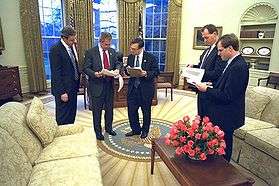
Bush's other major policy initiative upon taking office was education reforms. Although some congressional Republicans had called for abolishing the Department of Education, the President's success in campaigning on education reform had convinced many Republicans, including Congressman John Boehner of Ohio, that an education reform bill increasing federal funding would prove politically popular.[25] Seeking to craft a bipartisan bill, Bush sought out Democratic Senator Ted Kennedy, a leading liberal Senator who served as the ranking member on the Senate Committee on Health, Education, and Pensions. Bush proposed the No Child Left Behind Act, which required extensive testing to ensure that schools met uniform standards for skills such as reading and math. Bush hoped that testing would make schools more accountable for their performances and provide parents more information in choosing which schools to send their children. Kennedy shared Bush's concern for the education of impoverished children and hoped to increase federal funding for education, but he strongly opposed the president's proposed school vouchers, which would have allowed parents to use federal funding to pay for private schools. Both men cooperated to pass the No Child Left Behind Act, which dropped the concept of school vouchers but included Bush's idea of nationwide testing. Both houses of Congress registered overwhelming approval for the bill's final version, which Bush signed into law in January 2002.[26] However, Kennedy would later criticize the implementation of the act, arguing that Bush had promised great federal funding for education.[27]
Marriage, abortion, and faith
On his first day in office - January 20, 2001, President Bush moved to block federal aid to foreign groups that offered counseling or any other assistance to women in obtaining abortions.[28] Days later, he announced his commitment to channeling more federal aid to faith-based service organizations, despite the fears of critics that this would dissolve the traditional separation of church and state in the US.[29][30] To further this commitment, he created the White House Office of Faith-Based and Community Initiatives to assist faith-based service organizations.[31] In 2003, Bush signed the Partial-Birth Abortion Ban Act.[32]
Following a national furor over recognizing same-sex marriages in both San Francisco and Massachusetts, Bush announced his opposition to same-sex marriages in 2004 when endorsing the Federal Marriage Amendment to the US Constitution which would have permanently defined marriage as a union between a man and a woman.[33]
Euthanasia
Bush was staunchly opposed to euthanasia and supported Attorney General John Ashcroft's decision to file suit against the Oregon Death with Dignity Act, which was ultimately decided by the US Supreme Court favoring the Oregon law.[34] However, while he was governor of Texas, Bush had signed a law giving hospitals the authority to remove life support from terminally ill patients against the wishes of spouses or parents, if the doctors deemed it as medically appropriate.[35] This perceived inconsistency in policy became an issue in 2005, when Bush signed controversial legislation forwarded and voted on by only three members of the US Senate to initiate federal intervention in the court battle of Terri Schiavo, a comatose Florida woman who ultimately died.[36]
Stem cell research
Early in his administration, President Bush became personally interested in the issue of stem cell research. The Clinton administration had issued guidelines allowing the federal funding of research utilizing stem cells, and the Bush administration studied the situation's ethics. Evangelical religious groups argued that the research was immoral as it destroyed human embryos, while various advocacy groups touted the "miracle possibilities" of stem cell research. In August 2001, Bush announced that he opposed stem cell research, and he banned federal funding for research on new stem cell lines.[37]
In July 2006, Bush used his first presidential veto on the Stem Cell Research Enhancement Act, which would have expanded federal funding of embryonic stem cell research. A similar bill was passed in both the US House of Representatives and the Senate early in summer 2007 as part of House Speaker Nancy Pelosi's 100-Hour Plan. However, Bush vetoed the second bill as well and Congress could not override the veto.[38]
Surveillance and homeland security
Shortly after the September 11 attacks, Bush announced the creation of the Office of Homeland Security and appointed former Governor of Pennsylvania Tom Ridge its director. After Congress passed a law creating the Department of Homeland Security, Ridge became the first director of the newly-creatly department. The department was charged with overseeing immigration, border control, customs, and the newly-established Transportation Security Administration (TSA), which focused on airport security. On October 26, 2001, Bush signed into law the Patriot Act. Passed on the President's request, this act permitted increased sharing of intelligence among the US Intelligence Community and authorized the government to examine the credit card bills and library records of suspected terrorists. Bush also secretly authorized the National Security Agency to conduct warrantless surveillance of communications in and out of the US.[39]
Environmental policies
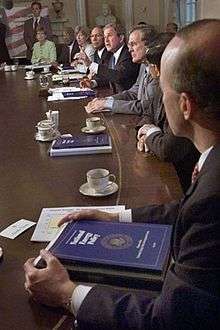
Bush's environmental record began with promises as a presidential candidate to clean up power plants and reduce greenhouse gas emissions. In a speech on September 29, 2000, Bush pledged to commit two billion dollars to the funding of clean coal technology research. In that same speech, he also promised to work with Congress, environmental groups, and the energy industry to reduce the emissions of sulfur dioxide, nitrogen oxide, mercury, and carbon dioxide into the environment within a "reasonable" period of time. He would later reverse his position on that specific campaign pledge in March 2001 in a letter to Nebraska Senator Chuck Hagel, stating that carbon dioxide was not considered a pollutant under the Clean Air Act, and that restricting carbon dioxide emissions would cause energy prices to rapidly increase.[40]
In March 2001, the G.W. Bush administration announced that it would not implement the Kyoto Protocol, an international treaty signed in 1997 in Kyoto, Japan that required nations to reduce their greenhouse gas emissions. The administration argued that ratifying the treaty would unduly restrict U.S. growth while unsuccessfully limiting emissions from developing nations.[41] In February 2002, President Bush announced his alternative to the Kyoto Protocol, by bringing forth a plan to reduce the intensity of greenhouse gases by 18% over 10 years. The intensity of greenhouse gases specifically is the ratio of greenhouse gas emissions and economic output (i.e., under this plan, emissions still continued to grow, but at a slower pace). Bush stated that this plan would prevent the release of 500 million metric tons of greenhouse gases, which is about the equivalent of removing 70 million cars from the road. This target would achieve this goal by providing tax credits to businesses that use renewable energy sources.[42]
President Bush stated that he believed global warming is real[43] but also a serious problem, although he asserted there existed a "debate over whether it's man-made or naturally caused".[44] The Bush Administration's stance on global warming remained controversial in the scientific and environmental communities. Critics alleged that the administration[45] misinformed the public and did not do enough to reduce carbon emissions and deter global warming.[46]
On January 6, 2009, President Bush designated the world's largest protected marine area. The Pacific Ocean habitat includes the Mariana Trench and the waters and corals surrounding three uninhabited islands in the Northern Mariana Islands, Rose Atoll in American Samoa, and seven islands along the equator.[47]
Campaign finance reform
In 1995, Senators John McCain (R-AZ) and Russ Feingold (D-WI) jointly published an op-ed calling for campaign finance reform, and began working on a bipartisan bill.[48][49] McCain's 2000 presidential campaign along with several scandals (including the Enron scandal) brought the issue of campaign finance to the fore of public consciousness in 2001.[48] Both McCain and Feingold pushed the bill in the Senate, while Chris Shays (R-CT) and Marty Meehan (D-MA) led the effort of passing it in the House.[48] In just the second successful use of the discharge petition since the 1980s, a mixture of Democrats and Republicans defied Speaker Dennis Hastert and passed a campaign finance reform bill.[50] The House approved the bill with a 240-189 vote, sending it to the Senate.[51] The bill passed the Senate in a 60-40 vote, the bare minimum required to overcome the filibuster.[49] Throughout the Congressional battle on the bill, Bush declined to take a strong position.[51] However, he signed the bill in March 2002 after it cleared both houses of Congress. However, in March 2002, Bush signed into law the Bipartisan Campaign Reform Act. In signing it, Bush stated that he thought the law would improve the financing system for elections but was "far from perfect."[52] The law placed several limits on political donations and expenditures, and closed loopholes on contribution limits on donations to political candidates by banning the use of so-called "soft money."[48] Portions of the law restricting independent expenditures would later be struck down the Supreme Court in the 2010 case of Citizens United v. FEC.[53]
Healthcare
After the passage of the Bush tax cuts and the No Child Left Behind Act, Bush then turned his domestic focus to healthcare. He sought to expand Medicare so it would also cover the cost of prescription drugs, a program that became known as Medicare Part D. Many congressional Democrats opposed the bill, arguing that it should have allowed Medicare to negotiate the prices of drugs, while many conservative Republicans also opposed the expansion of a government program. Along with House Speaker Dennis Hastert, he narrowly won approval of the bill in the House, while Senate Majority Leader Bill Frist overcame strong opposition in the Senate.[54] In December 2003, Bush signed the Medicare Prescription Drug, Improvement, and Modernization Act, the largest expansion of Medicare since the program's creation in 1965.[55]
Attempted Social Security reform
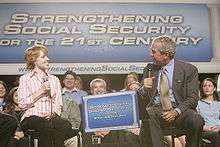
After winning re-election in 2004, Bush called for changes in Social Security as part of his vision of an "ownership society." He wanted to restructure the program for citizens to invest some of the money going in to the payroll taxes funding the program.[56] The President argued that Social Security faced an imminent funding crisis and that reform was necessary to ensure its continuing solvency.[57] However, Bush's plan earned unified opposition from congressional Democrats and failed to attract the necessary support from Republicans, and legislation on Social Security reform was never brought to a vote.[58]
Response to Hurricane Katrina
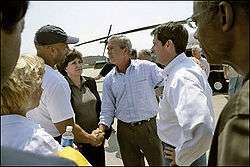
Hurricane Katrina, one of the largest and most powerful hurricanes ever to strike the United States, ravaged several states along the Gulf of Mexico in August 2005. On a working vacation at his ranch in Texas, Bush initially allowed state and local authorities to respond to the natural disaster. The hurricane made landfall on August 29, devastating the city of New Orleans after the failure of that city's levees. Over eighteen hundred people died in the hurricane, and Bush was widely criticized for his slow response to the disaster. His approval ratings fell below 40% and never recovered.[59]
Proposed immigration reform
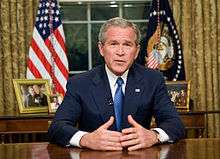
Alhough he concentrated on other domestic policies during his first term, Bush supported immigration reform throughout his administration. In May 2006, he proposed a five-point plan including increased border security, a guest worker program, and a path to citizenship for the twelve million illegal immigrants living in the United States. The Senate passed the Comprehensive Immigration Reform Act of 2006, which included many of the president's proposals, but the bill did not pass the House of Representatives. After Democrats took control of Congress in the 2006 mid-term elections, Bush worked with Ted Kennedy to re-introduce the bill as the Comprehensive Immigration Reform Act of 2007. The bill received intense criticism from many conservatives, who had become more skeptical of immigration reform, and it failed to pass the Senate.[60]
Great Recession
After years of financial deregulation accelerating under the Bush administration, banks began lending subprime mortgages to more and more home buyers, causing a housing bubble. Many of these banks also invested in credit default swaps and derivatives that were essentially bets on the soundness of these loans. When housing prices starting declining in 2007, the Bush administration began fearing a possible short recession, thus passing the Economic Stimulus Act of 2008. Falling home prices started threatening the financial viability of many institutions, and Bear Stearns, a prominent U.S.-based investment bank, was on the brink of failure in March 2008. Recognizing the growing threat of a financial crisis, Bush allowed Treasury Secretary Paulson to arrange for another bank, JPMorgan Chase, to tank over most Bear Stearn's assets. Out of concert that Fannie Mae and Freddie Mac might also fail, the Bush administration put both institutions into conservatorship. Shortly afterwords, the administration learned that Lehman Brothers was on the verge of bankruptcy. The administration's intervention in other financial institutions (often described as "bailouts") was criticized on both the left and the right. Both Bush and Paulson were reluctant to intervene on behalf of Lehman Brothers. The firm declared bankruptcy on September 15.[61]
Paulson hoped that the financial industry had shored itself up after the failure of Bear Stearns and that the failure of Lehman Brothers would not strongly impact the economy, but news of the failure caused stock prices to tumble and froze credit. American International Group (AIG), another major financial institution, teetered on the brink of failure. In fear a financial collapse, Paulson and the Federal Reserve took control of AIG. Hoping to shore up the other banks, Bush and Paulson proposed the Emergency Economic Stabilization Act of 2008, which would create the $700 billion Troubled Asset Relief Program (TARP), in which the federal government would buy toxic assets. The House rejected TARP in a 228-205 vote; although support and opposition crossed party lines, only about one third of the Republican caucus supported the bill. After the Dow Jones Industrial Average dropped 778 points on the day of the House vote, the House and Senate both passed TARP. Bush later extended TARP loans to U.S. automobile companies, which faced their own crisis due to the weak economy. TARP helped end the financial crisis, but it did not prevent the onset of the Great Recession.[62][63]
Other legislation
In July 2002, following several accounting scandals such as the Enron scandal, Bush signed the Sarbanes–Oxley Act into law. The act expanded reporting requirements for public companies[64] Shortly after the start of his second term, Bush signed the Class Action Fairness Act of 2005, which had been a priority of his administration and part of his broader goal of instituting tort reform. The act was designed to remove most class action lawsuits from state courts to federal courts, which were regarded as less sympathetic to plaintiffs in class action suits.[65]
Foreign affairs
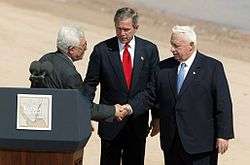
Upon taking office, Bush had little experience with foreign policy, and his decisions were guided by his advisers. Bush embraced the views of Cheney and other neoconservatives, who advocated for the spreading of democracy, by force if necessary. They also de-emphasized the importance of multilateralism, arguing that, as the world's lone superpower, the U.S. could act unilaterally if necessary. Though the first several months of his presidency focused on domestic issues, the Bush administration pulled the U.S. out of several existing or proposed multilateral agreements, including the Kyoto Protocol, the Anti-Ballistic Missile Treaty, and the International Criminal Court. Foreign affairs would increasingly come to the fore after the 9/11 attacks and the October 2001 invasion of Afghanistan.[66]
In 2002, during his State of the Union Address, Bush set forth what has become known as the Bush Doctrine. Although this doctrine was technically used for justifying the invasion of Afghanistan, it was not clearly stated as a matter of policy until this address. Because of the possibility of further massive terrorist attacks orchestrated by organizations that existed in multiple places all over the world, Bush stated that the United States would implement a policy of preemptive military strikes against nations known to be harboring or aiding a terrorist organization hostile to the United States. Bush outlined what he called the "Axis of Evil," consisting of three nations that, he argued, posed the greatest threat to world peace due to their pursuit of weapons of mass destruction and potential to aid terrorists. The axis consisted of Iraq, North Korea and Iran. Iraq would increasingly become the object of the administration's attention, and the 2003 invasion of Iraq and its aftermath became the central foreign policy issue of the Bush presidency.[67]
War in Afghanistan
September 11 attacks
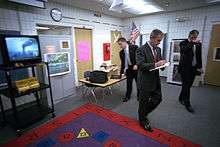
Terrorism had emerged as an important national security issue in the Clinton administration, and it became one of the dominant issues of the Bush administration[69] In the late 1980s, Osama bin Laden had established al-Qaeda, a militant Sunni Islamist multi-national organization. Bin Laden sought to defeat the so-called "Near Enemy," Western-backed governments in Saudi Arabia, Jordan, Egypt, and Pakistan. After Saudi Arabia began hosting U.S. soldiers in 1991, al-Qaeda conducted a terrorist campaign against U.S. targets, orchestrating attacks such as the 1998 USS Cole bombing. During Bush's first months in office, U.S. intelligence organizations intercepted communications indicating that al-Qaeda was planning another attack on the United States, but foreign policy officials were unprepared for a major attack on the United States.[70]
On September 11, 2001, al-Qaeda terrorists hijacked four airliners and flew two them into the twin towers of the World Trade Center in New York City, destroying both 110-story skyscrapers. Another plane crashed into Pentagon, while the final plane was brought down in Pennsylvania following a struggle between the terrorists and the aircraft's passengers.[71] The attacks had a profound effect on many Americans, who felt vulnerable to international attacks for the first time since the end of the Cold War.[72] Appearing on national television on the night of the attacks, Bush promised to punish those who had aided the attacks, stating, "we will make no distinction between the terrorists who committed these acts and those who harbor them." In the following days, Bush urged the public to renounce hate crimes and discrimination against Muslim-Americans and Arab-Americans.[71] He also declared a "War on Terror", instituting new domestic and foreign policies in an effort to prevent future terrorist attacks.[73]
Afghanistan
After 9/11, the Bush administration decided upon a decisive military action to punish the government of Afghanistan, which harbored the leaders of al-Qaeda. Bush's top foreign policy advisers were in agreement that launching strikes against al-Qaeda bases would not stop future attacks. Bush decided to lead an invasion of Afghanistan, with the ultimate goal of overthrowing the conservative Taliban government.[74] Powell took the lead in assembling allied nations in a coalition that would launch attacks on multiple fronts.[75] On September 14, Congress passed a resolution called the Authorization for Use of Military Force Against Terrorists, authorizing the president to use the military against those responsible for the attacks. On October 6, 2001 Bush authorized the invasion of Afghanistan.[74]
General Tommy Franks, the commander of the United States Central Command (CENTCOM), drew up a four-phase invasion plan. In the first phase, the U.S. built up forces in the surrounding area and inserted CIA and special forces operatives who linked up with the Northern Alliance, an Afghan resistance group opposed to the Taliban. The second phase consisted of a major air campaign against Taliban and al-Qaeda targets, while the third phase involved the defeat of the remaining Taliban and al-Qaeda forces. The fourth and final phase consisted of the stabilization of Afghanistan, which Franks projected would take three to five years. The war in Afghanistan began on October 7 with several air and missile strikes. On October 19, the Northern Alliance began its offensive, and the capital of Kabul was captured on November 13. Hamid Karzai was inaugurated as the new president of Afghanistan. However, the senior leadership of the Taliban and al-Qaeda, including bin Laden, avoided capture. Karzai would remain in power for the duration of Bush's presidency, but his effective control was limited to the area around Kabul, as various warlords took control of much of the rest of the country.[76] While the Karzai's government struggled to control the countryside, the Taliban regrouped in neighboring Pakistan. As Bush left office, he considered sending additional troops to bolster Afghanistan against the Taliban, but decided to leave the issue for the next administration.[77]
Guantanamo Bay and enemy combatants
During and after the invasion of Afghanistan, the U.S. captured numerous members of al-Qaeda and the Taliban. Rather than bringing the prisoners before domestic or international courts, Bush decided to set up a new system of military tribunals to try the prisoners. In order to avoid the restrictions of the United States Constitution, Bush held the prisoners in the Guantanamo Bay detention camp; because the camp is on territory that the U.S. technically leases from Cuba, individuals within the camp are not accorded the same constitutional protections that they would have on U.S. territory. Bush also decided that these "enemy combatants" were not entitled to all of the protections of the Geneva Conventions as they were not affiliated with states. While the administration established the camp at Guantanamo, it also authorized the creation of secret CIA prisons in various countries. In hopes of obtaining information from the prisoners, Bush allowed the use of "enhanced interrogation techniques" such as waterboarding.[78] The treatment of prisoners at Abu Ghraib, a U.S. prison in Iraq, elicited widespread outrage after photos of prisoner abuse were made public.[79] In 2005, Congress passed the Detainee Treatment Act, which purported to ban torture, but in his signing statement Bush asserted that his executive power gave him the authority to waive the restrictions put in place by the bill.[80] Bush's policies suffered a major rebuke from the Supreme Court in the 2006 case of Hamdan v. Rumsfeld, in which the court rejected Bush's use of military commissions without congressional approval and held that all detainees were protected by the Geneva Conventions.[81] Following the ruling, Congress passed the Military Commissions Act of 2006, which effectively overturned Hamdan.[82] The Supreme Court overturned a portion of that act in the 2008 case of Boumediene v. Bush, but the Guantanamo detention camp remained open at the end of Bush's presidency.[83]
Iraq
Prelude to the war

During the Presidency of George H. W. Bush, the United States had launched the Gulf War against Iraq after the latter invaded Kuwait. Though the U.S. defeated Iraq and threw it out of Kuwait, it left Saddam Hussein's administration in place, partly to serve as a counterweight to Iran. After the war, the Project for the New American Century, consisting of many individuals such as Wolfowitz and Cheney who would serve in both Bush administrations, advocated for the overthrow of Hussein.[85] In the days following the 9/11 attacks, hawks in the Bush administration such as Paul Wolfowitz argued for military action against Iraq, but the issue was set aside in favor of planning the invasion of Afghanistan.[86] Under the Clinton administration, the United States had adopted a policy of regime change against Saddam Hussein's Iraqi government, and some within the administration believed that it shared some responsibility for the 9/11 attacks. The administration also thought that Iraq possessed weapons of mass destruction (WMD) that could potentially threaten the U.S. and U.S. allies, possibly by providing those weapons to terrorists.[87] Many in the administration also hoped that the fall of Iraq would help spread democracy in the Middle East, deter the recruitment of terrorists, and increase the security of Israel By the end of 2001, while the war in Afghanistan was ongoing, the administration began drawing up military plans for an invasion of Iraq.[12]
In his 2002 State of the Union Address, Bush identified Iraq, Iran, and North Korea as the "axis of evil" due to their (WMD) programs and alleged sponsorship of terrorism. Throughout 2002, administration officials developed the Bush Doctrine, which called for preemptive and unilateral war when justified by national security interests.[88] Beginning in September 2002, the Bush administration mounted a campaign designed to win popular and congressional support for the war. Most congressional Republicans supported fell in line behind Bush, while leading Democrats like Hillary Clinton urged Bush to seek international support before going to war.[89] In October 2002, Congress approved the Iraq Resolution, authorizing the use of force against Iraq. While congressional Republicans almost unanimously supported the measure, congressional Democrats were split in roughly equal numbers between support and opposition to the resolution.[90] Bowing to domestic and foreign pressure, Bush sought to win the approval of the United Nations before launching an attack on Iraq.[91] Led by Powell, the administration won the November 2002 passage of United Nations Security Council Resolution 1441, which called on Iraq to dismantle its WMD program.[92]
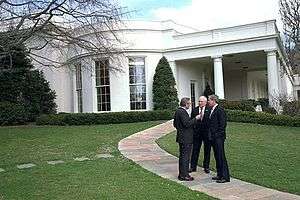
In December 2002, Iraq issued a report stating that it did not have a WMD program, but the U.S. rejected the report as false.[93] After a U.N. weapons inspections team led by Hans Blix, as well as another team led by Mohamed ElBaradei, failed to find evidence of an Iraqi WMD program, Bush's proposed regime change in Iraq faced mounting international opposition. Germany, China, France, and Russia all expressed skepticism about the need for regime change, and the latter three countries each possessed veto power on the United Nations Security Council.[94] At the behest of British Prime Minister Tony Blair, who supported Bush but hoped for more international cooperation, Bush dispatched Powell to the U.N. to make the case to the Security Council that Iraq maintained an active WMD program.[95] Though Powell's presentation preceded a shift in U.S. public opinion towards support of the war, it failed to convince the French, Russians, or Germans.[95] Contrary to the findings of Blix and ElBaradei, Bush asserted in a March 17 public address that there was "no doubt" that the Iraqi regime possessed weapons of mass destruction. Two days later, Bush authorized Operation Iraqi Freedom, and the Iraq War began on March 20, 2003.[96]
Invasion of Iraq
Allied forces, led by General Franks, launched a simultaneous air and land attack on Iraq on March 20, 2003, in what the American media called "shock and awe." With 145,000 soldiers, the ground force quickly overcome most Iraqi resistance, and thousands of Iraqi soldiers deserted. On April 7, the U.S. captured the Iraqi capital of Baghdad. However, Hussein escaped and went into hiding. While the U.S. and its allies had quickly achieved military success, the invasion was strongly criticized by many countries, and UN Secretary General Kofi Annan argued that the invasion was a violation of international law and the U.N. Charter.[97]
On May 1, 2003, Bush delivered the "Mission Accomplished speech," in which Bush declared the end of "major combat operations" in Iraq. Despite the failure to find evidence of an ongoing WMD program or an operational relationship between Hussein and al-Qaeda, Bush declared that the toppling of Hussein "removed an ally of al-Qaeda" and ended the threat that Iraq would supply weapons of mass destruction a terrorist organization. Believing that only a minimal residual American force would be required after the success of the invasion, Bush and Franks planned for a drawdown to 30,000 U.S. troops in Iraq by August 2003. But after the fall of Baghdad, Iraqis began looting their own capital, presenting one of the first of many challenges the U.S. would face in keeping the peace in Iraq.[98]
Bush appointed Paul Bremer to lead the Coalition Provisional Authority (CPA), which was charged with overseeing the transition to self-government in Iraq. In his first major order, Bremer announced a policy of de-Ba'athification, which denied government and military jobs to members of Hussein's Ba'ath Party. This policy angered many of Iraq's Sunnis, many of whom had joined the Ba'ath Party merely as a career move. Bremer's second major order disbanded the Iraqi military and police services, leaving over 600,000 Iraqi soldiers and government employees without jobs. Bremer also insisted that the CPA remain in control of Iraq until the country held elections, reversing Garner's plan to set up a transition government made up of Iraqis. These decisions contributed to the beginning of the Iraqi insurgency opposed to the continuing U.S. presence. Fearing the further deterioration of Iraq's security situation, General John Abizaid ordered the end of the planned drawdown of soldiers, leaving over 130,000 U.S. soldiers in Iraq. The U.S. captured Hussein in December 2003, but the occupation force continued to suffer casualties. Between the start of the invasion and the end of 2003, 580 U.S. soldiers died, with two thirds of those casualties occurring after Bush's "Mission Accomplished" speech.[99]
Continuing occupation
After 2003, more and more Iraqis began to see the U.S. as an occupying force. The fierce fighting of the First Battle of Fallujah alienated many in Iraq, while cleric Muqtada al-Sadr encouraged many Shia Muslims to oppose the CPA.[100] Sunni and Shia insurgents engaged in a campaign of guerilla warfare against the United States, blunting the technological and organizational advantages of the U.S. military.[101] While fighting in Iraq continued, domestic opposition to the war also strengthened, and many anti-war activists held protests against the Iraq War. In increasingly greater numbers, congressional Democrats such as Jack Murtha began attacking the war as well.[102] Bremer left Iraq in June 2004, transferring power to the Iraqi Interim Government, which was led by Ayad Allawi.[101] In January 2005, the Iraqi people voted on representatives for the Iraqi National Assembly, and the Shia United Iraqi Alliance formed a governing coalition led by Ibrahim al-Jaafari. In October 2005, the Iraqis ratified a new constitution that created a decentralized governmental structure dividing Iraq into communities of Sunni Arabs, Shia Arabs, and Kurds. After another election, Jafari was succeeded as prime minister by another Shia, Nouri al-Maliki. The elections failed to quell the insurgency, and hundreds of U.S. soldiers stationed in Iraq died during 2005 and 2006. Sectarian violence between Sunnis and Shias also intensified following the 2006 al-Askari mosque bombing.[103] In a December 2006 report, the bipartisan Iraq Study Group described the situation in Iraq as "grave and deteriorating," and the report called for the U.S. to gradually withdraw soldiers from Iraq.[104]
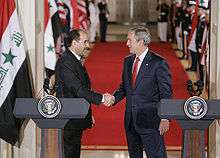
As the violence mounted in 2006, Rumsfeld and military leaders such as Abizaid and George Casey, the commander of the coalition forces in Iraq, called for a drawdown of forces in Iraq, but many within in the administration argued that the U.S. should maintain its troop levels.[105] Still intent on implementing a democratic Iraq, the Bush administration rejected a drawdown and began planning for a change in strategy and leadership following the 2006 elections.[106] After the elections, Bush replaced Rumsfeld with Gates, while David Petraeus replaced Casey and William J. Fallon replaced Abizaid.[107] Bush and his National Security Council formed a plan to "double down" in Iraq, increasing the number of U.S. soldiers in hopes of establishing a stable democracy.[108] After Maliki publicly announced his support for an increase of U.S. soldiers, Bush announced in January 2007 that the U.S. would send an additional 20,000 soldiers to Iraq as part of a "surge" of forces.[109] Though McCain and a few other hawks supported Bush's new strategy, many other members of Congress from both parties expressed doubt or outright opposition to it.[110]
In April 2007, Congress, now controlled by Democrats, passed a bill that called for a total withdrawal of all U.S. troops by April 2008, but Bush vetoed the bill.[111] Without the votes to override the veto, Congress passed a bill that continued to fund the war but also included the Fair Minimum Wage Act of 2007, which increased the federal minimum wage.[112] U.S. and Iraqi casualties continuously declined after May 2007, and Bush declared that the surge had been a success in September 2007.[113] He subsequently ordered a drawdown of troops, and the number of U.S. soldiers in Iraq declined from 168,000 in September 2007 to 145,000 when Bush left office.[113] The decline in casualties following the surge coincided with several other favorable trends, including the Anbar Awakening and Muqtada al-Sadr's decision to order his followers to cooperate with the Iraqi government.[114] In 2008, at the insistence of Maliki, Bush signed the U.S.–Iraq Status of Forces Agreement, which promised complete withdrawal of U.S. troops by the end of 2011.[115]
Israel
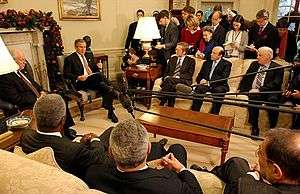
The Israeli–Palestinian conflict, ongoing since the middle of the 20th century, continued under Bush. After President Clinton's 2000 Camp David Summit had ended without an agreement, the Second Intifada had begun in September 2000.[116] While previous administrations had tried to act as a neutral authority between the Israelis and Palestinians, the Bush administration placed the blame for the violence on the Palestinians, angering Arab states such as Saudi Arabia.[116][117] However, Bush's support for a two-state solution helped smooth over a potential diplomatic split with the Saudis.[118] In hopes of establishing peace between the Israelis and Palestinians, the Bush administration proposed the road map for peace, but his plan was not implemented and tensions were heightened following the victory of Hamas in the 2006 Palestinian elections.[119]
Free trade agreements
Believing that protectionism hampered economic growth, Bush concluded free trade agreements with numerous countries. When Bush took office, the United States had free trade agreements with just three countries: Israel, Canada, and Mexico. In 2003, Bush signed the Chile–United States Free Trade Agreement, the Singapore–United States Free Trade Agreement, and he concluded the Morocco-United States Free Trade Agreement and the Australia–United States Free Trade Agreement the following year. He also concluded the Bahrain–United States Free Trade Agreement, the Oman–United States Free Trade Agreement, the Peru–United States Trade Promotion Agreement, and the Dominican Republic–Central America Free Trade Agreement. Additionally, Bush reached free trade agreements with South Korea, Colombia, and Panama, but agreements with these countries were not ratified until 2011.[120]
Russia
Bush emphasized creating a personal relationship with Russian President Vladimir Putin in order to ensure harmonious relations between the U.S. and Russia. After meeting with Putin in June 2001, both presidents expressed optimism regarding cooperation between the two former Cold War rivals.[121] After the 9/11 attacks, Putin allowed the U.S. to use Russian airspace, and Putin encouraged Central Asian states to grant basing rights to the U.S.[122] In May 2002, the U.S. and Russia signed the Strategic Offensive Reductions Treaty, which sought to dramatically reduce the nuclear stockpiles of both countries.[123]
Iran
In his 2002 State of the Union Address, Bush grouped Iran with Iraq and North Korea as a member of the "Axis of Evil", accusing Iran of aiding terrorist organizations.[124] In 2006, Iran re-opened three of its nuclear facilities, potentially allowing it to begin the process of building a nuclear bomb.[125] After the resumption of the Iranian nuclear program, many within the U.S. military and foreign policy community speculated that Bush might attempt to impose regime change on Iran.[126] In December 2006, the United Nations Security Council unanimously passed Resolution 1737, which imposed sanctions on Iran in order to curb its nuclear program.[127]
North Korea
North Korea had developed weapons of mass destruction for several years prior to the Bush administration, and the Clinton administration had sought to trade economic assistance for an end to the North Korean WMD program. Though Secretary of State Powell urged the continuation of the rapprochement, other administration officials, including Vice President Cheney, were more skeptical of the good faith of the North Koreans. Bush instead sought to isolate North Korea in the hope that the regime would eventually collapse.[128]
North Korea launched missile tests on July 5, 2006, leading to United Nations Security Council Resolution 1695. The country said on October 3, "The U.S. extreme threat of a nuclear war and sanctions and pressure compel the DPRK to conduct a nuclear test", which the Bush administration denied and denounced.[129] Days later, North Korea followed through on its promise to test nuclear weapons.[130] On October 14, the Security Council unanimously passed United Nations Security Council Resolution 1718, sanctioning North Korea for the test.[131] In the waning days of his presidency, Bush attempted to re-open negotiations with North Korea, but North Korea continued to develop its nuclear programs.[132]
AIDS relief
Shortly after taking office, Bush pledged $200 million to The Global Fund to Fight AIDS, Tuberculosis and Malaria.[133] Finding this effort insufficient, Bush assembled a team of experts to find the best way for the U.S. reduce the worldwide damage caused by the AIDS epidemic.[133] The experts, led by Anthony S. Fauci, recommended that the U.S. focus on providing antiretroviral drugs to developing nations in Africa and the Caribbean.[133] In his State of the Union message in January 2003, President Bush outlined a five-year strategy for global emergency AIDS relief, the President's Emergency Plan For AIDS Relief. With the approval of Congress, Bush committed $15 billion to this effort, which represented a huge increase compared to funding under previous administrations. Near the end of his presidency, Bush signed a re-authorization of the program that doubled its funding. By 2012, the PEPFAR program provided antiretroviral drugs for over 4.5 million people.[134]
International trips
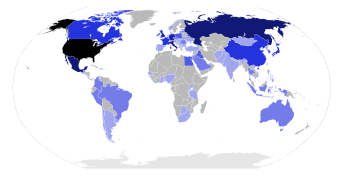
Bush made 48 international trips to 72 different countries (in addition to visiting the West Bank) during his presidency.[135]
He visited six continents: Africa, Asia, Australia, Europe, North America, and South America. On one of his two trips to Sub-Saharan Africa, he visited three of the poorest countries in the world: Liberia, Rwanda, and Benin. He was the first sitting president to visit: Albania, Bahrain, Benin, Estonia, Georgia, Iraq, Lithuania, Mongolia, Qatar, Slovakia, Sweden, and the United Arab Emirates. Bush also made a secret trip to Iraq on Thanksgiving Day 2003 to dine with the troops. His father had made a similar visit to the U.S. troops in Saudi Arabia in 1990. On November 15–20, 2006, Bush made the third round the world presidential flight (after Johnson and Nixon).
The number of visits per country where he travelled are:
- One visit to Albania, Argentina, Austria, Bahrain, Benin, Botswana, Bulgaria, Chile, Croatia, Denmark, El Salvador, Estonia, Georgia, Ghana, Guatemala, Hungary, India, Kosovo, Kuwait, Liberia, Lithuania, Mongolia, Netherlands, Nigeria, Pakistan, Panama, Philippines, Portugal, Qatar, Rwanda, Senegal, Slovakia, South Africa, Spain, Sweden, Tanzania, Turkey, Uganda, Ukraine, United Arab Emirates, Uruguay, Vietnam, and the West Bank
- Two visits to Afghanistan, Australia, Belgium, Brazil, Colombia, Czech Republic, Indonesia, Ireland, Israel, Jordan, Latvia, Peru, Romania, Saudi Arabia, Singapore, Slovenia, and Thailand
- Three visits to Egypt, South Korea, and Poland
- Four visits to Canada, China, France, Iraq, and Japan
- Five visits to Germany, the United Kingdom, and Vatican City
- Six visits to Italy and Mexico
- Seven visits to Russia
Controversies
CIA leak scandal
In July 2005, Bush and Vice President Dick Cheney's chief political advisors, Karl Rove and Lewis "Scooter" Libby respectively, came under fire for revealing the identity of covert Central Intelligence Agency (CIA) agent Valerie Plame to reporters in the CIA leak scandal. Libby resigned on October 28, hours after his indictment by a grand jury on multiple counts of perjury, false statements, and obstruction in this case. In March 2007, Libby was convicted on four counts, and Cheney pressed Bush to pardon Libby. Rather than pardoning Libby or allowing him to go to jail, Bush commuted Libby's sentence, creating a split with Cheney, who accused Bush of leaving "a soldier on the battlefield."[136]
Dismissal of United States attorneys
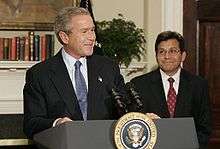
In December 2006, Bush dismissed eight United States Attorneys. Though these attorneys serve at the pleasure of the president, the large-scale mid-term dismissal was without precedent, and Bush faced accusations that he had dismissed the attorneys for purely political reasons. During the 2006 elections, several Republican officials complained that the U.S. attorneys had not sufficiently investigated voter fraud. With the encouragement of Harriet Miers and Karl Rove, Attorney General Gonzales dismissed eight U.S. attorneys who were considered insufficiently supportive of the administration's policies. Though Gonzales argued that the attorneys had been fired for performance reasons, publicly released documents showed that the attorneys were dismissed for political reasons. After Gonzales testified before the Senate in April 2007, several Senators from both parties asked Gonzales to resign. As a result of the dismissals and the subsequent congressional investigations, Rove and Gonzales both resigned. A 2008 report found from the Justice Department inspector general found that the dismissals had been politically motivated, but a special counsel found that no crimes had been committed and no one was ever prosecuted in connection to the dismissals.[137]
Approval ratings
Bush's approval ratings ran the gamut from high to all-time record low. Bush began his presidency with ratings near fifty percent.[138] In the time of national crisis following the September 11 attacks, polls showed approval ratings of greater than 85%, peaking in one October 2001 poll at 92%,[138] and a steady 80–90% approval for about four months after the attacks.[139] Afterward, his ratings steadily declined as the economy suffered and the Iraq War initiated by his administration continued. By early 2006, his average rating was averaging below 40%, and in July 2008, a poll indicated a near all-time low of 22%. Upon leaving office the final poll recorded his approval rating as 19%, a record low for any U.S. President.[138][140][141]
Elections during the Bush presidency
2002 mid-term elections
| Congress | Senate | House |
|---|---|---|
| 107th | 50[143] | 221 |
| 108th | 51 | 229 |
| 109th | 55 | 232 |
| 110th | 49 | 202 |
In the 2002 mid-term elections, Bush became the first president since the 1930s to see his own party pick up seats in both houses of Congress. Republicans picked up two seats in the Senate elections, allowing them to re-take control of the chamber.[144] Bush delivered speeches in several venues in support of his party, campaigning on his desire to remove the administration of Saddam Hussein. Bush saw the election results as a vindication of his domestic and foreign policies.[145]
2004 election
Bush and his campaign team seized on the idea of Bush as a "strong wartime leader," though this was undermined by the increasingly-unpopular Iraq War.[55] His conservative policies on tax cuts and several other issues appealed to many on the right, but Bush could also lay claim to some centrist achievements, including No Child Left Behind, Sarbanes-Oxley, and Medicare Part D.[146] Fearing that he might hurt Bush's re-election chances, Cheney offered to step down from the ticket, but Bush refused this offer, and the two were re-nominated without opposition at the 2004 Republican National Convention.[147] On the advice of pollster Matthew Dowd, who perceived a steady decline in the number of swing voters, the 2004 Bush campaign emphasized turning out conservative voters rather than the persuasion of moderates.[148]
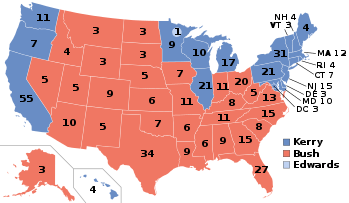
In the 2004 Democratic primaries, Senator John Kerry of Massachusetts defeated several other candidates, effectively clinching the nomination on March 2. A Vietnam War veteran, Kerry had voted to authorize the Iraq War but had come to oppose it.[149] The Bush campaign sought to define Kerry as a "flip-flopper" due to his vote on a bill funding the Afghanistan and Iraq wars.[150] Kerry sought to convince Republican Senator John McCain to become his running mate, but chose Senator John Edwards of North Carolina for the position after McCain rejected the offer.[151] The election saw a major jump in turnout; while 105 million people had voted in 2000, 123 million people voted in 2004. Bush won 50.7% percent of the popular vote, making him the first individual to win a majority of the popular vote since United States presidential election, 1988, while Kerry took 48.3% of the popular vote. Bush won 286 electoral votes, winning Iowa, New Mexico, and every state he won in 2000 except for New Hampshire.[152]
2006 mid-term elections
Damaged by the unpopularity of the Iraq War and President Bush, the Republicans lost control of both houses of Congress in the 2006 elections. Republicans were also damaged by various scandals, including the Jack Abramoff Indian lobbying scandal and the Mark Foley scandal. The elections confirmed Bush's declining popularity, as many of the candidates he had personally campaigned for were defeated. After the elections, Bush announced the resignation of Rumsfeld, and promised to work with the new Democratic majority.[153]
2008 election and transition

Under the terms of the twenty-second amendment, Bush was ineligible to seek a third term in 2008. Senator John McCain won the 2008 Republican primaries, while Democratic Senator Barack Obama of Illinois defeated Hillary Clinton to win the Democratic presidential nomination. McCain sought to distance himself from the unpopular policies of Bush, and Bush appeared only by satellite at the 2008 Republican National Convention, making him the first sitting president since Lyndon Johnson to not appear at his own party's convention.[154] Though McCain briefly took the lead in polls of the race taken after the convention, Obama quickly re-took the lead, and he retained for the remainder of the campaign.[155] Obama won 365 electoral votes and 52.9% of the popular vote. The election gave Democrats unified control of the legislative and executive branches for the first time since the 1994 elections. After the election, Bush congratulated Obama and invited him to the White House. With the help of the Bush administration, the presidential transition of Barack Obama was widely regarded as successful, particularly for a transition between presidents of different parties.[156] During his inauguration on January 20, 2009, Obama thanked Bush for his service as president and his support of Obama's transition.[157]
Evaluation and legacy
Polls of historians and political scientists taken after 2009 have generally ranked Bush as a below-average president at best and absolutely awful at worst. Historians have also concluded that he is one of the worst presidents to serve more than one term in office. A 2009 C-SPAN survey of historians ranked Bush in 36th place among the 42 former presidents.[158] A 2017 C-Span poll of historians ranked Bush as the 33rd greatest president.[159] A 2018 poll of the American Political Science Association's Presidents and Executive Politics section ranked Bush as the 30th greatest president.[160]
In summing up evaluations of Bush's presidency, Gary L. Gregg II writes:
The Bush presidency transformed American politics, its economy, and its place in the world, but not in ways that could have been predicted when the governor of Texas declared his candidacy for America's highest office. As President, Bush became a lightning rod for controversy. His controversial election and policies, especially the war in Iraq, deeply divided the American people. Arguably his greatest moment as President was his initial, heartfelt response to the tragedy of the 9/11 attacks. Soon, however, his administration was overshadowed by the wars in Afghanistan and Iraq. President Bush's place in U.S. history will be debated and reconsidered for many years to come.[161]
See also
References
- ↑ Mann, pp. 31-37
- 1 2 Mann, pp. 35-42
- ↑ Smith, pp. 152-156
- ↑ Smith, pp. 134-135
- ↑ Smith, pp. 389-390
- ↑ Smith, pp. 610-611
- ↑ Smith, pp. 419-420
- ↑ Smith, pp. 491-492
- ↑ Smith, pp. 572-575
- ↑ Mann, pp. 53-54, 76-77
- ↑ Smith, pp. 129-134
- 1 2 Herring, pp. 938–939
- ↑ Smith, pp. 382-383
- ↑ Smith, pp. 417-418
- ↑ Smith, pp. 515-517
- ↑ Herring, p. 959
- ↑ Smith, pp. 427-428, 445-452
- ↑ All figures, except for debt percentage, are presented in billions of dollars. GDP is calculated for the calendar year. The income, outlay, deficit, and debt figures are calculated for the fiscal year, which ends on September 30. For example, fiscal year 2017 ended on September 30, 2017.
- ↑ Represents the national debt held by the public as a percentage of GDP
- ↑ "Historical Tables". Obama White House. Table 1.1: Office of Management and Budget. Retrieved 23 May 2018.
- ↑ "Historical Tables". Obama White House. Table 1.2: Office of Management and Budget. Retrieved 23 May 2018.
- ↑ "Historical Tables". Obama White House. Table 7.1: Office of Management and Budget. Retrieved 23 May 2018.
- ↑ Smith, pp. 160-161
- 1 2 Mann, pp. 43-48, Smith, pp. 161-162
- ↑ Smith, pp. 163-164
- ↑ Smith, pp. 166-167
- ↑ Mann, pp. 50-52
- ↑ Office of the Press Secretary (2001-01-22). "Memorandum for Restoration of the Mexico City Policy". The White House. Retrieved 2006-06-30.
- ↑ Buckley, Thomas E. (2002-11-11). "Church, State and the Faith-Based Initiative". America, The National Catholic Weekly. Archived from the original on 2006-05-29. Retrieved 2006-06-30.
- ↑ Brancaccio, David (2003-09-26). "Faith-based Initiatives". God and Government. NOW, PBS. Retrieved 2006-06-30.
- ↑ "GEORGE W. BUSH: DOMESTIC AFFAIRS". Miller Center. University of Virginia.
- ↑ Murphy, Jarrett (18 September 2003). "Bush Signs 'Partial Birth' Ban". CBS. Retrieved 15 November 2017.
- ↑ "Bush calls for ban on same-sex marriages". CNN. 25 February 2004. Retrieved 15 November 2017.
- ↑ Johnson, Kevin (2002-04-18). "Federal judge backs Oregon suicide law". USAToday. Retrieved 2006-06-30.
- ↑ Knight Ridder; Newsday (2005-03-22). "As governor, Bush signed right-to-die law". Seattle Times. Archived from the original on 2006-02-28. Retrieved 2006-06-30.
- ↑ Babington, Charles; Allen, Mike (2005-03-21). "Congress Passes Schiavo Measure". The Washington Post. Retrieved 2006-06-30.
- ↑ Mann, pp. 49-50
- ↑ Gay Stolberg, Cheryl (21 June 2007). "Bush Vetoes Measure on Stem Cell Research". New York Times. Retrieved 8 April 2017.
- ↑ Mann, pp. 63-65
- ↑ "Bush reverses position on emissions reductions". CNN. March 14, 2001. Archived from the original on December 10, 2008. Retrieved May 22, 2010.
- ↑ "US blow to Kyoto hopes". BBC News. March 28, 2001. Retrieved May 22, 2010.
- ↑ "Bush unveils voluntary plan to reduce global warming". CNN. February 14, 2002. Archived from the original on December 12, 2008. Retrieved May 22, 2010.
- ↑ "Interview with President Bush". White House Transcript. Politico. May 13, 2008. Retrieved May 14, 2008.
Q. Mr. President, for the record, is global warming real? A. Yes, it is real, sure is.
- ↑ "Press Conference". The White House. June 26, 2006. Archived from the original on May 2, 2013. Retrieved September 1, 2008.
- ↑ "NASA Scientist Rips Bush on Global Warming". MSNBC. October 27, 2004. Archived from the original on May 7, 2013. Retrieved September 1, 2008. ; "60 Minutes: Rewriting the Science". CBS News. March 19, 2006. Archived from the original on April 13, 2006. Retrieved September 1, 2008.
- ↑ Romm, Joe (2006). Hell or High Water. William Morrow. ISBN 978-0-06-117212-0. OCLC 77537768. ; Romm calls Bush's "don't rush to judgment" and "we need to ask more questions" stance a classic delay tactic. Part 2.
- ↑ Suzanne Goldenberg: "Bush designates ocean conservation areas in final weeks as president" – guardian.co.uk, January 6, 2009
- 1 2 3 4 Gitell, Seth (August 2003). "Making Sense of McCain-Feingold and Campaign-Finance Reform". The Atlantic. Retrieved 17 November 2017.
- 1 2 Welch, William (20 March 2002). "Passage ends long struggle for McCain, Feingold". USA Today. Retrieved 16 October 2015.
- ↑ Ehrenfreund, Max (29 June 2013). "The discharge petition's role in the immigration reform debate, explained". Washington Post. Retrieved 16 October 2015.
- 1 2 Barrett, Ted (15 February 2002). "Campaign finance battle moves to Senate". CNN. Retrieved 16 October 2015.
- ↑ "Bush Signs Campaign Finance Reform Law". Fox News. 27 March 2002. Retrieved 23 February 2017.
- ↑ Bai, Matt (17 July 2012). "How Much Has Citizens United Changed the Political Game?". New York Times. Retrieved 17 November 2017.
- ↑ Smith, pp. 390-39
- 1 2 Mann, pp. 88-89
- ↑ Smith, pp. 425-426
- ↑ Prokop, Andrew (9 January 2017). "In 2005, Republicans controlled Washington. Their agenda failed. Here's why". Vox. Retrieved 8 April 2017.
- ↑ Weisberg, Jacob (31 March 2005). "Bush's First Defeat". Slate. Retrieved 7 April 2017.
- ↑ Smith, pp. 430-443
- ↑ Smith, pp. 582-584
- ↑ Mann, pp. 126-132
- ↑ Mann, pp. 132-137
- ↑ Smith, pp. 631-632, 659-660
- ↑ Bumiller, Elizabeth (31 July 2002). "CORPORATE CONDUCT: THE PRESIDENT; Bush Signs Bill Aimed at Fraud In Corporations". New York Times. Retrieved 23 February 2017.
- ↑ Harris, John F.; Branigin, William (18 February 2005). "Bush Signs Class-Action Changes Into Law". Washington Post. Retrieved 18 November 2017.
- ↑ Smith, pp. 181-182, 193
- ↑ Smith, pp. 277-278
- ↑ CNN, By Bryan Monroe,. "Witness to history: White House photographer and the images of 9/11".
- ↑ Herring, pp. 936, 941
- ↑ Herring, pp. 939–941
- 1 2 Mann, pp. 58-60
- ↑ Herring, pp. 941–942
- ↑ Smith, pp. 254-256
- 1 2 Mann, pp. 61-66
- ↑ Herring, p. 942
- ↑ Herring, pp. 942–943
- ↑ Smith, pp. 249-251, 602-605
- ↑ Mann, pp. 66-71
- ↑ Smith, pp. 384-387
- ↑ Smith, pp. 465-471
- ↑ Smith, pp. 499-501
- ↑ Smith, pp. 505-507
- ↑ Smith, pp. 508-509
- ↑ "'Building momentum for regime change': Rumsfeld's secret memos". 16 February 2013.
- ↑ Smith, pp. 179-180
- ↑ Mann, pp. 61-63
- ↑ Mann, pp. 72-75, 78-81
- ↑ Herring, pp. 943–944
- ↑ Herring, pp. 947–949
- ↑ Smith, pp. 321-325
- ↑ Smith, pp. 312-314
- ↑ Smith, pp. 330-331
- ↑ Smith, pp. 333-334
- ↑ Smith, pp. 338-340
- 1 2 Smith, pp. 343-345
- ↑ Smith, pp. 353-355
- ↑ Smith, pp. 356-361
- ↑ Smith, pp. 362-367
- ↑ Smith, pp. 368-380, 396
- ↑ Smith, pp. 396-399
- 1 2 Smith, pp. 479-481
- ↑ Smith, pp. 429-430, 462-463
- ↑ Smith, pp. 482-487
- ↑ Smith, pp. 533-534
- ↑ Smith, pp. 494-496
- ↑ Smith, pp. 512-515
- ↑ Smith, pp. 518-519, 543-544
- ↑ Smith, pp. 529-532
- ↑ Smith, pp. 546-548
- ↑ Smith, pp. 549-551
- ↑ Smith, pp. 576-577
- ↑ Smith, pp. 578-579
- 1 2 Smith, pp. 596-597
- ↑ Smith, pp. 598-600
- ↑ Smith, pp. 600-601
- 1 2 Smith, pp. 204-206
- ↑ Gay Stolberg, Sheryl (2 August 2006). "Bush and Israel: Unlike his father - Americas - International Herald Tribune". New York Times. Retrieved 8 April 2017.
- ↑ Smith, pp. 214-215
- ↑ Kessler, Glenn (15 June 2007). "Takeover by Hamas Illustrates Failure of Bush's Mideast Vision". Washington Post. Retrieved 8 April 2017.
- ↑ Smith, pp. 585-586
- ↑ Smith, pp. 199-203
- ↑ Smith, pp. 248-249
- ↑ Smith, pp. 306-307
- ↑ "How Iran Entered the 'Axis'". PBS. Retrieved 15 November 2017.
- ↑ Weisman, Steven; Fathi, Nazila (11 January 2006). "Iranians Reopen Nuclear Centers". New York Times. Retrieved 15 November 2017.
- ↑ Hersh, Seymour M. (17 April 2006). "The Iran Plans". New Yorker. Retrieved 15 November 2017.
- ↑ Gootman, Elissa (24 December 2006). "Security Council Approves Sanctions Against Iran Over Nuclear Program". New York Times. Retrieved 15 November 2017.
- ↑ Mann, pp. 186-189
- ↑ "North Korea pledges to test nuclear bomb". CNN. 2006-10-04. Retrieved 2006-10-16.
- ↑ NBC News and lnews services (2006-10-16). "U.S. confirms N. Korean blast was radioactive". MSNBC. Retrieved 2006-10-16.
- ↑ Associated Press (2006-10-14). "Security Council Unanimously Approves Sanctions on N. Korea". Fox News Channel. Retrieved 2006-10-14.
- ↑ Kessler, Glenn (13 March 2015). "Cotton's misguided history lesson on the North Korean nuclear deal". Washington Post. Retrieved 8 April 2017.
- 1 2 3 Smith, pp. 553-554
- ↑ Mann, pp. 91-92
- ↑ "Travels of President George W. Bush". U.S. Department of State Office of the Historian.
- ↑ Smith, pp. 452-455
- ↑ Smith, pp. 564-575
- 1 2 3 Roper Center (2009). "Job Performance Ratings for President Bush". Archived from the original on February 28, 2009. Retrieved March 9, 2009.
- ↑ USA Today (May 20, 2005). "CNN/USA TODAY/GALLUP Poll".
- ↑ PollingReport.com. "PRESIDENT BUSH – Overall Job Rating in national polls". Archived from the original on 2008-09-13.
- ↑ "The National Economy". americanresearchgroup.com. February 19, 2009. Archived from the original on January 25, 2009.
- ↑ Republican seats at the start of each session of Congress. Independents caucusing with the Democratic Party (Jim Jeffords, Bernie Sanders, and Joe Lieberman) are counted as Democrats for the purposes of this table. Throughout Bush's presidency, there were a total of 100 Senate seats in 435 House seats, so a Republican majority in the Senate required 50 seats (since Republican Vice President Dick Cheney could provide the tie-breaking vote), and a Republican majority in the House required 218 seats (assuming no vacancies).
- ↑ In June 2001, Jim Jeffords left the Republican Party and began caucusing with the Democrats, giving the Democrats a majority. Democrats also briefly had the majority in January 2001, before the swearing in of Vice President Cheney.
- ↑ Mann, pp. 78-79
- ↑ Smith, pp. 329-330
- ↑ Mann, pp. 92-93
- ↑ Smith, pp. 383-384
- ↑ Smith, pp. 392-393
- ↑ Smith, pp. 401-403
- ↑ Mann, pp. 96-97
- ↑ Smith, pp. 404-405
- ↑ Smith, pp. 412-415
- ↑ Smith, pp. 519-526
- ↑ Smith, pp. 634-637
- ↑ Smith, pp. 637-638
- ↑ Smith, pp. 638-639
- ↑ Smith, pp. 652-654
- ↑ Walsh, Kenneth T. (February 17, 2009). "Historians Rank George W. Bush Among Worst Presidents". US News and World Report. Retrieved November 19, 2015.
- ↑ "Presidential Historians Survey 2017". C-Span. Retrieved 14 May 2018.
- ↑ Rottinghaus, Brandon; Vaughn, Justin S. (19 February 2018). "How Does Trump Stack Up Against the Best — and Worst — Presidents?". New York Times. Retrieved 14 May 2018.
- ↑ Gregg II, Gary L. "GEORGE W. BUSH: IMPACT AND LEGACY". Miller Center. University of Virginia. Retrieved 16 May 2018.
Works cited
- Herring, George C. (2008). From Colony to Superpower; U.S. Foreign Relations Since 1776. Oxford University Press. ISBN 978-0-19-507822-0.
- Mann, James (2015). George Bush. Times Books.
- Smith, Jean Edward (2016). Bush. Simon & Schuster.
Further reading
Academic
- Abramson, Paul R., John H. Aldrich, and David W. Rohde. Change and Continuity in the 2004 and 2006 Elections (2007), 324pp excerpt and text search
- Allard, Scott W. "The Changing Face of Welfare During the Bush Administration." Publius 2007 37(3): 304–332. ISSN 0048-5950
- Baker, Peter (2013). Days of Fire: Bush and Cheney in the White House. Doubleday.
- Berggren, D. Jason, and Nicol C. Rae. "Jimmy Carter and George W. Bush: Faith, Foreign Policy, and an Evangelical Presidential Style." Presidential Studies Quarterly. 36#4 2006. pp 606+. online edition
- Campbell, Colin, Bert A. Rockman, and Andrew Rudalevige, eds.. The George W. Bush Legacy Congressional Quarterly Press, 2007, 352pp; 14 essays by scholars excerpts and online search from Amazon.com
- Congressional Quarterly. CQ Almanac Plus highly detailed annual compilation of events in Congress, White House, Supreme Court, summarizing the weekly "Congressional Quarterly Weekly Report". (annual, 2002–2009)
- Conlan, Tim and John Dinan. "Federalism, the Bush Administration, and the Transformation of American Conservatism." Publius 2007 37(3): 279–303. ISSN 0048-5950
- Corrado, Anthony, E. J. Dionne Jr., Kathleen A. Frankovic. The Election of 2000: Reports and Interpretations (2001) online edition
- Daynes, Byron W. and Glen Sussman. "Comparing the Environmental Policies of Presidents George H. W. Bush and George W. Bush." White House Studies 2007 7(2): 163–179. ISSN 1535-4768
- Desch, Michael C. "Bush and the Generals." Foreign Affairs 2007 86(3): 97–108. ISSN 0015-7120 Fulltext: Ebsco
- Eckersley, Robyn. "Ambushed: the Kyoto Protocol, the Bush Administration's Climate Policy and the Erosion of Legitimacy." International Politics 2007 44(2–3): 306–324. ISSN 1384-5748
- Edwards III, George C. and Philip John Davies, eds. New Challenges for the American Presidency New York: Pearson Longman, 2004. 245 pp. articles from Presidential Studies Quarterly
- Edwards III, George C. and Desmond King, eds. The Polarized Presidency of George W. Bush (2007), 478pp; essays by scholars; excerpt and online search from Amazon.com
- Fortier, John C. and Norman J. Ornstein, eds. Second-term Blues: How George W. Bush Has Governed (2007), 146pp excerpt and online search from Amazon.com
- Graham John D. Bush on the Home Front: Domestic Policy Triumphs and Setbacks (Indiana University Press, 2010) 425 pages; covers taxation, education, health care, energy, the environment, and regulatory reform.
- Greenstein, Fred I. ed. The George W. Bush Presidency: An Early Assessment Johns Hopkins University Press, 2003
- Greenstein, Fred I. "The Contemporary Presidency: The Changing Leadership of George W. Bush A Pre- and Post-9/11 Comparison" in Presidential Studies Quarterly v 32#2 2002 pp 387+. online edition
- Gregg II, Gary L. and Mark J. Rozell, eds. Considering the Bush Presidency Oxford University Press, 2004. 210 pp. British perspectives
- Hendrickson, Ryan C., and Kristina Spohr Readman, "From the Baltic to the Black Sea: Bush's NATO Enlargement." White House Studies. (2004) 4#3 pp: 319+. online edition
- Hilliard, Bryan, Tom Lansford, and Robert P Watson, eds. George W. Bush: Evaluating the President at Midterm SUNY Press 2004
- Jacobson, Gary C. "The Bush Presidency and the American Electorate" Presidential Studies Quarterly v 33 No.4 2003 pp 701+. online edition
- Jacobson, Gary C. "Referendum: the 2006 Midterm Congressional Elections." Political Science Quarterly 2007 122(1): 1–24. ISSN 0032-3195 Fulltext: Ebsco
- Milkis, Sidney M. and Jesse H.Rhodes. "George W. Bush, the Party System, and American Federalism." Publius 2007 37(3): 478–503. ISSN 0048-5950
- Moens, Alexander The Foreign Policy of George W. Bush: Values, Strategy, and Loyalty. Ashgate, 2004. 227 pp.
- Rabe, Barry. "Environmental Policy and the Bush Era: the Collision Between the Administrative Presidency and State Experimentation." Publius 2007 37(3): 413–431. ISSN 0048-5950
- Sabato, Larry J. ed. The Sixth Year Itch: The Rise and Fall of the George W. Bush Presidency (2007), experts on the 2006 elections in major states
- Strozeski, Josh, et al. "From Benign Neglect to Strategic Interest: the Role of Africa in the Foreign Policies of Bush 41 and 43." White House Studies 2007 7(1): 35–51. ISSN 1535-4768
- Updegrove, Mark K. (2017). The Last Republicans: Inside the Extraordinary Relationship between George H.W. Bush and George W. Bush. Harper. ISBN 9780062654120.
- Wekkin, Gary D. "George H. W. Bush and George W. Bush: Puzzling Presidencies, or the Puzzle of the Presidency?" White House Studies 2007 7(2): 113–124. ISSN 1535-4768
- Wong, Kenneth and Gail Sunderman. "Education Accountability as a Presidential Priority: No Child Left Behind and the Bush Presidency." Publius 2007 37(3): 333–350. ISSN 0048-5950
- Zelizer, Julian E., ed. (2010). The Presidency of George W. Bush: A First Historical Assessment. Princeton University Press. ISBN 9780691134857.
Reflections on the Bush presidency
- Barnes, Fred. Rebel-in-Chief: How George W. Bush Is Redefining the Conservative Movement and Transforming America (2006)
- Bartlett, Bruce. Impostor: How George W. Bush Bankrupted America and Betrayed the Reagan Legacy (2006)
- Cheney, Dick. In My Time: A Personal and Political Memoir (2011)
- Draper, Robert. Inside the Bush White House: The Presidency of George W. Bush (2007)
- Ferguson, Michaele L. and Lori Jo Marso. W Stands for Women: How the George W. Bush Presidency Shaped a New Politics of Gender (2007)
- Gerson, Michael J. Heroic Conservatism: Why Republicans Need to Embrace America's Ideals (And Why They Deserve to Fail If They Don't) (2007), excerpt and text search
- Greenspan, Alan. The Age of Turbulence: Adventures in a New World (2007)
- Hayes, Stephen F. Cheney: The Untold Story of America's Most Powerful and Controversial Vice President (2007), excerpts and online search
- Hughes, Karen. George W. Bush: Portrait of a Leader (2005)
- Mabry, Marcus. Twice as Good: Condoleezza Rice and Her Path to Power (2007)
- Moore, James. and Wayne Slater. Bush's Brain: How Karl Rove Made George W. Bush Presidential (2003) online edition
- Rice, Condoleezza. No Higher Honor: A Memoir of My Years in Washington (2011)
- Rumsfeld, Donald. Known and Unknown: A Memoir (2011)
- Suskind, Ron. The Price of Loyalty: George W. Bush, the White House, and the Education of Paul O'Neill (2004), excerpts and online search from Amazon.com
- Woodward, Bob. Plan of Attack (2003), excerpt and text search
Primary sources
- Bush, George W. George W. Bush on God and Country: The President Speaks Out About Faith, Principle, and Patriotism (2004)
- Bush, George W. Decision Points (2010)
External links
- George W. Bush White House archives
- The Bush Years: High and Low Points – slideshow by The First Post
- George W. Bush Presidency – collection of academic articles on the Bush Presidency.
| U.S. Presidential Administrations | ||
|---|---|---|
| Preceded by Clinton |
G. W. Bush Presidency 2001–2009 |
Succeeded by Obama |

